
RARE Vintage Double Bobblehead Verizon US Olympics Bobsled Team USA Team
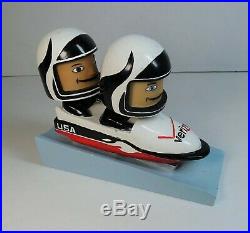
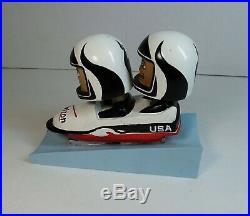
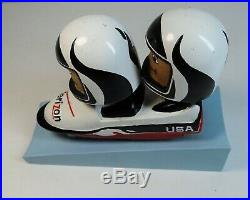
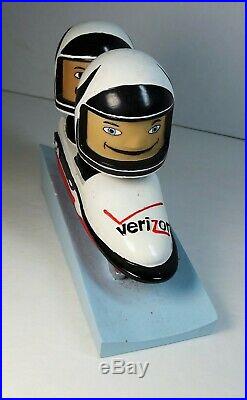
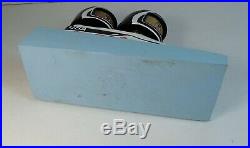
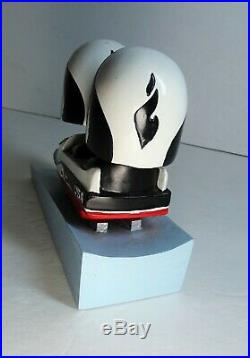

RARE Vintage Bobble Head. USA – Olympic Bobsled Team. For offer, a very nice old bobble! Fresh from an old prominent estate. Never offered on the market until now. Vintage, Old, Original – NOT a Reproduction – Guaranteed!! This came from an estate in the Finger Lakes, near Rochester. Not sure of the age. Base measures just under 6 inches x 2 1/8 inches. Two men in sled. In good to very good condition. A few small areas of light crackling on top of one helmet. Please see photos and scans for all details and condition. If you collect 20th century Americana sports history, toys, American olympics, advertisement ad, etc. This is a nice lot for your collection. A bobblehead, also known as a nodder, wobbler or bobble head, is a type of collectible doll. Its head is often oversized compared to its body. Instead of a solid connection, its head is connected to the body by a spring or hook[1] in such a way that a light tap will cause the head to bobble, hence the name. German “Wackeldackel”, bobblehead dachshund. During the seventeenth century, figurines of Buddha and other religious figures called “temple nodders” were produced in Asia. [2] The earliest known Western reference to a bobblehead is thought to be in Nikolai Gogol’s 1842 short story “The Overcoat”, in which the main character’s neck was described as “like the necks of plaster cats which wag their heads”. [3] During the nineteenth century, bisque-based bobbleheads were being made in limited quantities for the US market. [2] Many of the bobbleheads in the US were produced in Germany, with an uptick in imports during the 1920s and 30s. [4] By the 1950s, bobbleheads had a substantial surge in popularity, with items made of either plastic or bisque. By 1960, Major League Baseball had gotten in on the action and produced a series of Papier-mâché Bobblehead dolls, one for each team, all with the same cherubic face, and a few select players over time. [5] The World Series held that year brought the first player-specific baseball bobbleheads, for Roberto Clemente, Mickey Mantle, Roger Maris, and Willie Mays, still all with the same face. [6] Over the next decade bobbleheads were also created with ceramics. [7] Within a few years, they would be produced for other sports, [8] as well as cartoon characters. [9] One of the most famous bobbleheads of all time also hails from this era: The Beatles bobblehead set, [10] which is a valuable collectible today. The next increase in popularity took place during the late 1990s. [11] Although older bobbleheads like the baseball teams and The Beatles were sought after by collectors during this period, new bobblehead dolls were few and far between. What finally prompted their resurgence was cheaper manufacturing processes, and the main bobblehead material switched, this time from ceramic to plastic. It was now possible to make bobbleheads in the very limited numbers necessary for them to be viable collectibles. 2, 1997, the minor league Birmingham Barons gave away Barons Bobblehead Doll bobbleheads at a game. [12] The first major league baseball team to offer a bobblehead giveaway was the San Francisco Giants, which distributed 35,000 Willie Mays head nodders at their May 9, 1999 game. The variety of bobbleheads has grown to include even relatively obscure popular culture figures and notable people. [13][14] The new millennium would bring a new type of bobblehead toy, the mini-bobblehead, standing just two or three inches tall and used for cereal prizes and such. Post Cereals in particular packaged 22 million mini-bobble heads of MLB players with its cereal before opening day in 2002. On November 18, 2014, it was announced that the National Bobblehead Hall of Fame and Museum would open in 2016 in Milwaukee, Wisconsin. The National Bobblehead HOF and Museum held a preview exhibit at RedLine Milwaukee from January 7th, 2016 through April 30, 2016, [16] which showcased the largest public display of bobbleheads in history. [17] The 2000s also saw the rise of a competitive market for personalized, on-demand bobbleheads, typically 67 inches tall, from a number of on-line vendors. [18] In 2015 the Pope Francis bobblehead became so popular that a nationwide shortage was reported. January 7, 2015 marked the inaugural National Bobblehead Day. [20] In 2016 the Guinness Book of World Records mark for world’s largest bobblehead was set at 15 feet tall. Named “Goldie”, it was the result of a collaboration between Dino Rentos and BobbleHeads. Thanjavur dolls of India. Main article: Tanjore doll. Thanjavur dolls are a type of Indian bobblehead dolls known as “Thanjavur Thalayatti Bommai” in the Tamil language, meaning “Tanjore Head-Shaking Doll”. They are a native art form in the Thanjavur region of Tamil Nadu state in South India. These dolls are usually 6″ to 12″ tall (15 to 30 cm). They are made of clay or wood and painted over in bright colors, and are often dressed up in fancy clothes. [22] They form a part of an elaborate display of dolls known as “Golu (kolu)”, exhibited in Indian houses during the “Dasara (Navaratri)” festival in Sep-Oct. Sports teams sometimes give away bobbleheads at their games, for example the Los Angeles Kings gave away some honoring Luc Robitaille on his induction to the Hockey Hall of Fame. In the 1986 “Let’s Go Mets” music video, there is a scene where Joe Piscopo, standing outside the New York Mets’ dugout at Shea Stadium, taps four Mets bobblehead dolls, then goes into the dugout and taps the heads of four actual Mets players (Howard Johnson, Bob Ojeda, Rick Aguilera, Kevin Mitchell) who “bobble” their heads in a similar fashion. Piscopo then attempts to tap a fifth player (Lee Mazzilli) but is rebuffed and subsequently tackled by all of the players. In 2001, Audi broadcast commercials in Europe featuring an Elvis impersonator and a prototypical Wackel-Elvis (“Wobble Elvis” or “Wobbly Elvis”) dashboard figure with a wobbling left arm and hip. Due to subsequent demand 165,000 Wackel-Elvis dashboard figures were produced. Since 2003, American law journal The Green Bag has issued bobblehead dolls depicting Justices of the Supreme Court of the United States, both present and past. In the season two episode “Valentine’s Day” of NBCs The Office U. TV Series, Dwight is given a bobblehead doll as a Valentine’s gift, from Angela. In 2010, 14-year-old Henry Ermer of Brooklyn, New York, attempted to enter the Guinness Book of World Records by building what is believed to be the world’s largest bobblehead, standing 16 feet tall. On the 2012 season premiere episode of ABC’s The Bachelorette, contestant Chris Bukowski presented bachelorette Emily Maynard with custom bobbleheads of the two of them in an attempt to impress her and further himself in the competition. Promotional merchandise by American corporations. Newsies “Broadway” Bobblehead[33]. Richardson e-learning 5 Year trade show give away. Dave Brown (meteorologist) WMC-TV Bobblehead[35][36]. Bobsleigh or bobsled is a winter sport in which teams of two or four teammates make timed runs down narrow, twisting, banked, iced tracks in a gravity-powered sleigh. The timed runs are combined to calculate the final score. The various types of sleds came several years before the first tracks were built in St. Moritz, Switzerland, where the original bobsleds were adapted upsized luge/skeleton sleds designed by the adventurously wealthy to carry passengers. Competition naturally followed, and to protect the working class and rich visitors in the streets and byways of St Moritz, bobsledding was eventually banned from the public highway. In the winter of 1903/1904 the Badrutt family, owners of the historic Kulm Hotel and the Palace Hotel, allowed Emil Thoma to organise the construction of the first familiarly configured’half-pipe’ track in the Kulm Hotel Park, ending in the village of Cresta. It has hosted the sport during two Olympics and is still in use today. International bobsleigh competitions are governed by the International Bobsleigh and Skeleton Federation, also known as FIBT from the French Fédération Internationale de Bobsleigh et de Tobogganing. National competitions are often governed by bodies such as the United States Bobsled and Skeleton Federation and Bobsleigh Canada Skeleton. The item “RARE Vintage Double Bobblehead Verizon US Olympics Bobsled Team USA Team” is in sale since Monday, March 18, 2019. This item is in the category “Collectibles\Pinbacks, Bobbles, Lunchboxes\Bobbleheads, Nodders\Modern (1970-Now)\Sports”. The seller is “dalebooks” and is located in Rochester, New York. This item can be shipped worldwide.
- Modified Item: No
- Country/Region of Manufacture: United States

Categories
- 10pc
- 1910's
- 1920's
- 1930's
- 1940's
- 1950s
- 1960's
- 1960-61
- 1961-1963
- 1961-62
- 1961-63
- 1961-66
- 1962-1964
- 1963-65
- 1965-67
- 1966-1971
- 1967-1971
- 1970-80s
- 1970s
- 1980's
- 1994-1998
- 60's
- 75th
- acre
- action
- adam
- adorable
- adventures
- ahsoka
- airplan
- alien
- allen
- alvin
- amazing
- american
- amtrak
- anaheim
- andy
- angeles
- angles
- angry
- animated
- annual
- another
- anri
- anthony
- antique
- antiquevintage
- april
- apsco
- arizona
- armor
- army
- asian
- asmr
- astronaut
- astros
- athletics
- atlanta
- auburn
- austin
- authentic
- autographed
- avengers
- babe
- backs
- bakersfield
- baldwin
- balitmore
- baltimare
- baltimore
- barack
- barn
- barney
- bartolo
- base
- baseball
- baseballkid18
- basketball
- batman
- beastly
- beatles
- beautiful
- beavis
- been
- believe
- bell
- bernie
- best
- betty
- bigfoot
- biggest
- bilbo
- bird
- birthday
- bisque
- black
- blatz
- blossom
- bob's
- boba
- bobbie
- bobbing
- bobble
- bobblehead
- bobbleheads
- bobby
- boltz
- boneco
- bonnie
- boston
- botton
- bought
- bowl
- bowler
- brady
- braves
- break
- brett
- brian
- brief
- brock
- brucey
- bubbles
- buffalo
- bull
- burton
- butter
- buying
- buzz
- california
- calus
- cameloot
- canada
- canadian
- captain
- carbonado
- cardinal
- cardinals
- carl's
- carlos
- carolina
- cartoon
- casey
- casper
- celestion
- celluloid
- ceramic
- chalk
- changes
- channel
- charlie
- charming
- chase
- chattanooga
- chciago
- check
- chennai
- cheryl
- chevrolet
- chevy
- chicago
- chief
- chihuahua
- child
- chinese
- chipper
- chris
- christina
- christmas
- chuck
- cincinatti
- cincinnati
- cincinnatti
- circa
- cisco
- classic
- clemson
- cleveland
- click
- coach
- coco
- colin
- collectible
- collection
- collector
- colonel
- colorado
- columbus
- community
- complete
- conan
- concept
- connor
- cool
- coolest
- corgi
- cory
- could
- country
- coyote
- crazy
- creating
- crosley
- cubs
- custom
- cute
- dale
- dallas
- dancing
- dark
- dashboard
- davar
- dave
- david
- days
- deadpool
- deal
- deck
- definitely
- denny
- densuke
- denver
- derek
- determind
- detroit
- dexter
- dick
- diego
- dilla
- dirty
- disney
- disney's
- disneyland
- displaying
- distinctive
- dodger
- dodgers
- doll
- dolls2get
- double
- driving
- duke
- dumpster
- dwight
- eagles
- earl
- early
- easter
- easy
- ebay
- eggs
- elby
- elephant
- empire
- england
- epic
- episode
- eric
- eskimo
- estate
- european
- evel
- excellent
- extra
- extremely
- fabulous
- fall
- fallout
- fantastic
- favorite
- feeding
- felix
- feller
- fidel
- figuras
- figurebobblehead
- final
- finally
- finding
- first
- fisherman
- five
- fixing
- flea
- flocked
- florida
- foco
- foghorn
- football
- force
- fossil
- found
- four
- francisco
- franciso
- freddy
- free
- french
- friday
- friends
- frosty
- fruits
- fujiya
- fukuoka
- funko
- funny
- garage
- geek
- gehrig
- geico
- gemmy
- genuine
- george
- georgia
- german
- getting
- ghost
- ghostbusters
- giant
- giants
- gobble-bobble
- gold
- golden
- good
- goodwill
- goose
- gopro
- gorton
- gotta
- grade
- great
- greatest
- greatful
- green
- gremlins
- griffey
- groovin
- guardians
- guitar
- halladay
- halloween
- hamilton
- hanna
- hannah
- happy
- hariko-no-torapaper-mache
- harlem
- harry
- hasbro
- haul
- hauling
- haunted
- haute
- haven
- hawaiian
- hayden
- heart
- hearts
- heico
- hell
- hello
- herky
- herman
- hermann
- hershey
- heyde
- high
- hollywood
- home
- homies
- honest
- horse
- houston
- huge
- hugh
- hula
- humpback
- hunting
- huskies
- ichiro
- ideal
- impala
- inch
- incredible
- indiana
- indianapolis
- insane
- inspired
- intel
- iowa
- iron
- isotopes
- jack
- jackie
- jackpot
- jacoby
- january
- japan
- japanese
- jeff
- jeremy
- jerry
- jewelry
- jimi
- jock
- john
- john's
- johnny
- jose
- julius
- jungle
- justin
- kansas
- kareem
- kelly
- kentucky
- khrushchev
- kicking
- kids
- kildare
- king
- kingston
- kissin
- kissing
- knott's
- kobe
- kokeshi
- korody
- korody-colyer
- kreiss
- lace
- large
- largest
- larry
- laughing
- lawyer
- lebowski
- lebron
- legends
- lego
- lilly
- linea
- listing
- literally
- little
- live
- loaded
- local
- look
- looking
- lootcrate
- louis
- lucky
- lucy
- macinnis
- made
- make
- makeover
- malt-o-meal
- mandalorian
- mardi
- mars
- marvel
- marvin
- marx
- mascots
- matching
- mcdonald
- mcdonalds
- meadow
- meet
- metal
- mets
- mexican
- miami
- michael
- michigan
- mickey
- mighty
- mike
- miles
- millionaire
- milwaukee
- mimics
- mini
- miniature
- minnesota
- mint
- miss
- mohammed
- mommy
- monnie
- montreal
- moose
- more
- mortal
- moses
- most
- moving
- muk-luk
- museum
- mutt
- mystery
- nabemacollectibles
- napcoware
- napoleon
- national
- nationals
- ncaa
- nebraska
- neca
- need
- negro
- neighborhood
- nelly
- newark
- nice
- nightmare
- nintendo
- nodder
- nodders
- nolan
- north
- northwestern
- notre
- nrfb
- nrmt
- nsync
- nygiantsmuseum
- oakland
- obama
- official
- ohio
- ollie
- opening
- orbit
- oregon
- original
- orioles
- orleans
- oscar
- pablo
- pacific
- pack
- packed
- pair
- panda
- pandora
- paper
- patrck
- patriot
- patriots
- paul
- pawn
- peabody
- peanut
- peanuts
- peek
- penn
- peoria
- personal
- personalized
- pete
- philadelphia
- phillie
- phillies
- photoshop
- pickers
- piece
- pierre
- piggly
- pikachu
- pineapple
- pirate
- pirates
- pittsburgh
- planned
- plaster
- play
- player
- playing
- playset
- pokemon
- police
- political
- popeye
- porcelain
- portland
- poster
- pre-war
- presale
- princeton
- pro-novelty
- probobble
- pukin
- pull
- purdue
- purple
- quakes
- queen
- rams
- random
- rangers
- rare
- rare-vintage
- real
- redbird
- reddy
- reggie
- repacked
- repair
- repaired
- resellers
- reselling
- resident
- restaurant
- retro
- reveal
- review
- ribbie
- richie
- roberto
- roblox
- robocop
- rock
- rocky
- roger
- rogers
- rollie
- rolling
- rosen
- royal
- rudolph
- rumpus
- russ
- rustic
- ryan
- saint
- sales
- salinas
- sammy
- sams
- sandy
- sanfl
- santa
- saturday
- saved
- savers
- scarce
- scooby
- scooby-doo
- scully
- sculpting
- seattle
- seaver
- secret
- selling
- sewcial
- shenandoah
- shimamura
- ship
- shop
- shopping
- show
- showbiz
- showcase
- sicks
- sigmund
- signed
- simmons
- skull
- slow
- smokey
- snooopy
- snoop
- snoopy
- solar
- sold
- solo
- somerset
- south
- spacecowboy
- span
- sparky
- special
- spent
- spock
- spooktacular
- spool
- sports
- spring
- stanford
- star
- starbucks
- starting
- steelers
- step
- steve
- stinking
- stlcollectibles
- stop
- storage
- strong
- studio
- super
- supercross
- suzy
- sweet
- taiwan
- take
- talking
- talky
- tampa
- tc56
- team
- territory
- texas
- there
- thomas
- thousand
- three
- thrift
- thrifting
- thrifty
- tiger
- tigers
- time
- toes
- tokyo
- tommy
- tony
- topo
- topps
- toronto
- tour
- toys
- trading
- transformers
- trojans
- truly
- trust
- tsubakuro
- tulane
- turn
- turning
- twilight
- twofortheshow
- tyler
- u0026
- u0026b
- ultimate
- ultra
- unboxing
- Uncategorized
- uncle
- underdog
- unexpected
- unique
- universal
- university
- unknown
- unlocking
- unlv
- upper
- used
- vegas
- very
- video
- vince
- vintag
- vintage
- vintage'60s
- vintage-new
- vintage1960's
- vintage1983
- vintage2002
- vintageantique
- vintagerare
- vintg
- vintge
- vntg
- vtg'04
- vtg'50's
- vtg'61
- vtg-1960s-pittsburgh-pirates-mascot-bobble-head-nodder-green-square-base
- vtg-diamond
- vtg1960s
- vtgantique
- wabac
- wacky
- walt
- walter
- wanted
- washington
- watch
- waterloo
- wayne
- weard
- weeble
- weekly
- welcome
- went
- west
- wham
- whats
- white
- wigglin
- wiggling
- williams
- willie
- wilt
- wind
- winning
- winnipeg
- wisconsin
- woodzeez
- world
- worst
- wrestling
- yale
- yankees
- yard
- york
- yvan
- zelda
- zombie
Archives
- July 2025
- June 2025
- May 2025
- April 2025
- March 2025
- February 2025
- January 2025
- December 2024
- November 2024
- October 2024
- September 2024
- August 2024
- July 2024
- June 2024
- May 2024
- April 2024
- March 2024
- February 2024
- January 2024
- December 2023
- November 2023
- October 2023
- September 2023
- August 2023
- July 2023
- June 2023
- May 2023
- April 2023
- March 2023
- February 2023
- January 2023
- December 2022
- November 2022
- October 2022
- September 2022
- August 2022
- July 2022
- June 2022
- May 2022
- April 2022
- March 2022
- February 2022
- January 2022
- December 2021
- November 2021
- October 2021
- September 2021
- August 2021
- July 2021
- June 2021
- May 2021
- April 2021
- March 2021
- February 2021
- January 2021
- December 2020
- November 2020
- October 2020
- September 2020
- August 2020
- July 2020
- June 2020
- May 2020
- April 2020
- March 2020
- February 2020
- January 2020
- December 2019
- November 2019
- October 2019
- September 2019
- August 2019
- July 2019
- June 2019
- May 2019
- April 2019
- March 2019
- February 2019
- January 2019
- December 2018
- November 2018
- October 2018
- September 2018
- August 2018
- July 2018
- June 2018
- May 2018
- April 2018
- March 2018
- February 2018
- January 2018
- December 2017
- November 2017
- October 2017
- September 2017
- August 2017
- July 2017
- June 2017
- May 2017
- April 2017
- March 2017
- February 2017
- January 2017
- December 2016
- November 2016
- October 2016
- September 2016
- August 2016
- July 2016
- June 2016
- May 2016
- April 2016
- March 2016
- February 2016
- January 2016
- December 2015
- November 2015
- October 2015
- September 2015
- August 2015
- July 2015